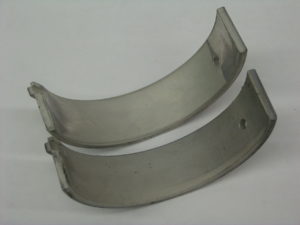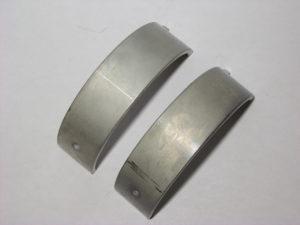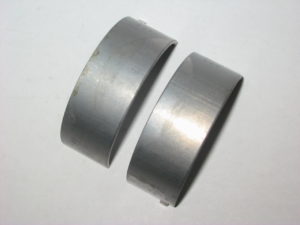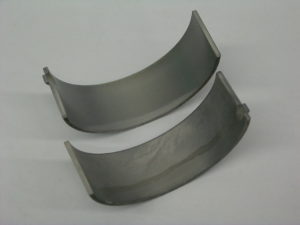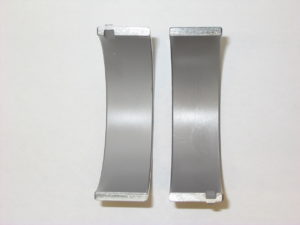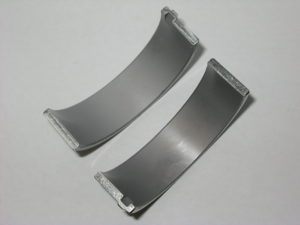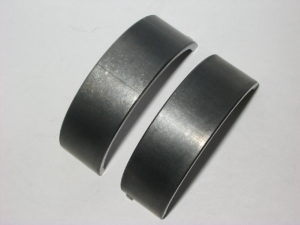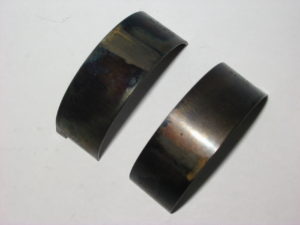When Rebuilding Porsche 996 and 997 Turbo Engines, Which Engine Bearings Should Be Used?
Engine Bearings Paper No 1
These are extremely important in an engine and are often taken for granted until there is a failure. Then it is often head scratching time. Of the two “main” types in an engine, the rod bearing typically takes the most abuse.
Both main and rod bearings can only survive if there is an oil film between the bearing shell and the crankshaft journal. This is the measured clearance that is very critical. It sets and maintains the oil pressure and the film thickness. Too much clearance and the oil pressure will be compromised. There are many other factors that affect the engine bearing, the oil viscosity, engine speed, engine operating temperatures, journal RA finish, to list a few.
In the Porsche engine, the main bearings are supplied oil from a main oil galley running parallel to the crankshaft within the engine case, on the 4/5/6 side of the engine case. This oil is then pushed into the clearance between the bearings and crankshaft through holes in the bearing shells. The oil film is not created by the pressure pushing the oil, but the rotation of the crankshaft. The oil is pulled into the cavity and the crankshaft is “raised” off the main bearings by this wedge of oil.
The rod bearings are fed from within the “center” of the crankshaft from each direction. Oil enters the crankshaft through the #1 and # 8 main bearing shells. The #1 main bearing is a grooved type and the #8 bearing is “open” within its inner diameter. The purpose of these grooves is to feed oil to the rods. The #2 through #7 main have only a single feed hole and no grooves. They only have to feed oil to the main journal they support. In some engines, grooved mains are on the upper shell only as this shell typically see lower loads than the lower partner shell. Using non grooved shells on the lower side gives the journal a thicker film of oil to support the loads. In the Porsche engine, both sides of the main bearing are grooved as there is no bottom or top as the parting line is vertical not horizontal. The Rod bearings are raised off the crankshaft journals in the same manner as the crankshaft is raised off the main bearing shells. In Porsche engines with crankshafts that use “direct” oiling to each adjacent rod, have main journals grooved to support the rod bearing oiling. This is done as there are no grooved main bearings available for these engines.
The bearing shells themselves can add an element of safety. Not all bearings are alike, and there are two main categories that need to be known: street bearings and those designed and manufactured for high performance use. Street bearings are designed for longevity and low wear. They are typically Bi metal construction, with a steel backing with an aluminum silicone alloy overlay. They can also be aluminum with a tin overlay. Both are extremely hard, wear very slowly and contain no lead. Zero lead in cars is also a major factor both here in the US and in the EU.
The Bi metal bearings are good for engines that produce upwards of 500-600 HP. This is why they can be found in all Porsche street engines. However, if you have “hot-rodded” your engine above the performance levels these Bi metal bearings are designed for, you may have, or should expect, bearing failure. When the performance of an engine is increased, the firing pressure or combustion forces pushing down on the upper rod bearing shells increases exponentially, and the forces push against the oil film between the bearing shell and crankshaft journal. These forces pound the oil film until it is “squeezed out” which results in the bearing shell touching the journal. Bi metal bearings are extremely hard, have no give, and do not deform under these extreme loads and will instantaneously weld themselves to the crankshaft journal. It takes milliseconds for the damage to occur. If we look at a 6-cylinder engine, at 5000 RPM it rotates 83.3 times per second. In each rotation, the Rod and Main bearings all do a complete rotation around their paired crankshaft journal. Each Rod bearing shell rotates 83.3 times per second. Increase the speed to 8000 and the number increase to 133.3 times or rotations. Now it is easy to understand why bearings and the oil film are critical and knowledge of when to use what type is so important. The Bi metal bearings usually have a very shiny and bright surface. This is an easy way to tell them apart and find out what type they are. Another way is to carefully “dig” the surface with a sharp object. Typically, there will be no damage or mark visible.
If you have an engine that produces more than 500-600 HP, then a high performance bearing is required. In the Porsche engine, the rod bearing is the only bearing we can substitute easily. Main bearings are not typically available in high performance variants. Connecting rods are subject to extremely high loads. The highest loads are the inertia loadings when the rod is at TDC on the exhaust stroke. This is when the weight of the piston, pin, rings, clips and the small end of the rod all combine and try to pull collective masses out through the top of the engine. It puts extreme loads on the rod cap, bolts and tries to stretch the rods themselves. This stretching elongates the vertical dimension of the rod big end and narrows the width of the bearing across the rod parting line. As this dimension shrinks, so does the clearance and the oil film. For this reason, high performance bearings are thinner at the parting line to counter act this narrowing effect. It is called bearing eccentricity.
Tri metal bearings are designed for these performance levels. These have 3 layers, and usually have hardened steel back with tin or copper-lead underlay, and an overlay of babbit. They deform under pressure and are soft due to the use of the babbit material in the overlay. This allows the bearing to “touch” the crankshaft journal under extreme pressure without welding itself to the journal.
In a lot of cases, the 996 and 997 turbo crankshafts are used in performance turbo engines. The rod journals are narrow and the standard bearing length is just over 0.700”. This short length bearing increases the surface pressure and, along with the use of Bi metal bearings, increases the chances of failure. Add in the oiling issues with the stock crankshafts, and it is no wonder the center bearing shells fail often. Lower pressure, lower volume due to the oiling of the rods from the center of the crankshaft, the use of stock rod bearing with extremely hard surfaces all add to the possibility and often bearing failure. I have seen where performance levels have been increased resulting in the stock rods bending under these extreme loads. If the loads are so great that the stock rods bend, imagine the loads placed upon the bearings and the oil film. Often, the rods are replaced with a rod of a stronger design, but the same design and construction of bearing shells are re used. I think it is easy to see something that is or has failed like a bent rod and replaced, but something that is not seen or understood is left to potentially fail again. These are the sorts of things that come under the heading of “some see it wrong and fix it and others do not see it at all’.
Performance Developments has developed a modification to the stock crankshaft rod journals that allows the use of a Tri metal high performance rod bearing. It requires a different connecting Rod BE bore to be used to house a slightly smaller bearing shell. There are no free lunches unfortunately\ and this upgrade is for those that know the value of risk management over cost. Wear patterns on both the main and rod bearing shells can tell how the engine is operating. This is why the most important part of any engine rebuild is the disassembly and inspection before cleaning takes place. All too often the bearings are disregarded in disassembly, never inspected and the faults within the engine never addressed.
In Engine Bearings paper no. 2, wear patterns, failure types and causes, clearances required, journal finishes and the different types of bearing will be discussed.
These images show the stock Porsche OEM Bi-Metal Main and Rod bearing. Front and Back.
In comparison, these are high performance bearings that have hardened steel backings and Tri-Metal overlays including a soft babbit top layer.
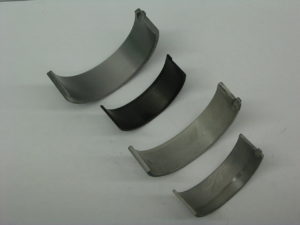
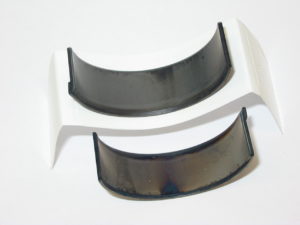
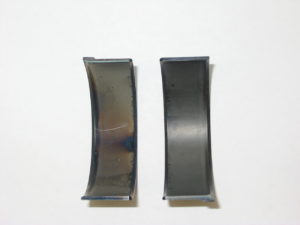 These bearings are custom race bearings designed for the McLaren twin turbo V8 engine with Tri-Metal overlays.
These bearings are custom race bearings designed for the McLaren twin turbo V8 engine with Tri-Metal overlays.
These images show the visual differences between stock Bi-Metal and race high performance Tri-Metal bearings.
